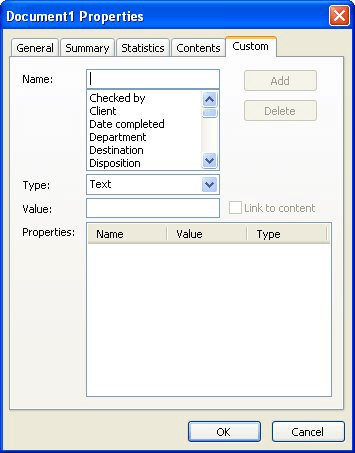Please Note: This article is written for users of the following Microsoft Word versions: 97, 2000, 2002, and 2003. If you are using a later version (Word 2007 or later), this tip may not work for you. For a version of this tip written specifically for later versions of Word, click here: Creating Custom Document Properties.
Written by Allen Wyatt (last updated March 11, 2023)
This tip applies to Word 97, 2000, 2002, and 2003
Besides your actual document, Word also maintains quite a bit of statistical and overview information about your document. You can view a portion of this information by choosing the Properties option from the File menu. Word then displays the Properties dialog box for your document, and you can use the different tabs to view the information maintained.
In addition to the standard properties maintained by Word, you can create your own custom document properties. These can then be used within your document (using the DOCPROPERTY field) or within macros. To create a custom document property, follow these steps:

Figure 1. The Custom tab of the Properties dialog box.
WordTips is your source for cost-effective Microsoft Word training. (Microsoft Word is the most popular word processing software in the world.) This tip (661) applies to Microsoft Word 97, 2000, 2002, and 2003. You can find a version of this tip for the ribbon interface of Word (Word 2007 and later) here: Creating Custom Document Properties.

The First and Last Word on Word! Bestselling For Dummies author Dan Gookin puts his usual fun and friendly candor back to work to show you how to navigate Word 2019. Spend more time working and less time trying to figure it all out! Check out Word 2019 For Dummies today!
Word provides access to a wide variety of characters either from the keyboard or from the Symbol dialog box. Up and above ...
Discover MoreNeed to move a few paragraphs around in your document? Word provides a couple of handy shortcuts that make it very easy ...
Discover MoreNonprinting characters are a great boon when you are editing a document. Turn them on and you can easily see what ...
Discover MoreFREE SERVICE: Get tips like this every week in WordTips, a free productivity newsletter. Enter your address and click "Subscribe."
There are currently no comments for this tip. (Be the first to leave your comment—just use the simple form above!)
Got a version of Word that uses the menu interface (Word 97, Word 2000, Word 2002, or Word 2003)? This site is for you! If you use a later version of Word, visit our WordTips site focusing on the ribbon interface.
Visit the WordTips channel on YouTube
FREE SERVICE: Get tips like this every week in WordTips, a free productivity newsletter. Enter your address and click "Subscribe."
Copyright © 2025 Sharon Parq Associates, Inc.
Comments